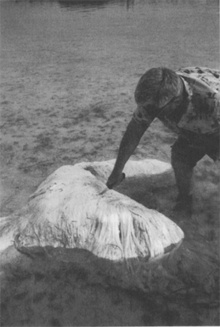Bermuda Blob
Bermuda Blob is the name given to two globsters that washed ashore on Bermuda in 1988 and 1997. Originally thought to be the remains of a cryptid, analysis proved the blobs to be the remains of whales.

1988
The first Bermuda Blob was found by Teddy Tucker, a fisherman and treasure hunter, in Mangrove Bay in May 1988. Tucker described the blob as "2½ to 3 feet thick ... very white and fibrous ... with five 'arms or legs,' rather like a disfigured star."[1] Samples of the specimen were analysed in 1995 and it was suggested that these were from a poikilothermic sea creature, either a large teleost (bony fish) or an elasmobranch (shark or ray).[2] Subsequent reanalysis of this specimen by the same team, however, using advanced genetic techniques not previously available, confirmed that it was actually the remains of a whale.[3]
1997

Bermuda Blob 2 was found in January 1997. Analysis of samples in 2004 suggests that Bermuda Blob 2 was a large mass of adipose tissue from a whale.[3]
References
- Ellis, R. 1994. Monsters of the Sea. Robert Hale, London.
- Pierce, S., G. Smith, T. Maugel & E. Clark 1995. On the Giant Octopus (Octopus giganteus) and the Bermuda Blob: homage to A. E. Verrill. Biological Bulletin 188: 219–230.
- Pierce, S., S. Massey, N. Curtis, G. Smith, C. Olavarría & T. Maugel 2004. Microscopic, biochemical, and molecular characteristics of the Chilean Blob and a comparison with the remains of other sea monsters: nothing but whales. Biological Bulletin 206: 125–133.
- Puig, R. 2004. A Whale of a Tale. Research Online, University of South Florida.